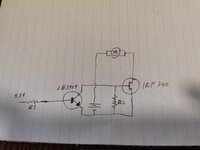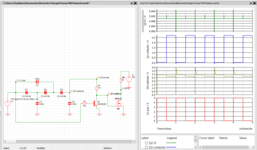Just-s
Newbie
Note that I don't have any experience in electronics so general tips and explanations are also appreciated.
The goal is switch a 5v 1A DC motor with a logic level signal(eventually a microcontroller) powered by a 5v power supply.
To do this I originally got a IRF740 MOSFET. Since then I learned that at 4.5v Vgs it merely begins to switch on, but it is not enough to allow a 1A drain source current.
I know there exist "logic level MOSFETs" which are made exactly for that, but I am trying to work with the components I currently have.
I also have some BJTs and while none of them are capable of a 1A collector-emitter current I thought it should be possible to switch to switch the MOSFET with it.
The idea is: the MOSFETs gate is connected to the BJTs(2N3904) collector. The low current 3.3V input voltage is connected to the BJTs base. Emitter is connected to common negative rail.
However the MOSFET does not seem to be switched on. If i replace the MOSFET with an LED it lights up, so I'm confident that i got that part of the circuit right.
Additional questions:
1. When the BJT is off, I measured the collector/emitter voltage, it was around 4 volts. Is it normal? Can a voltage exist without current?
2. As I understood, the MOSFET is a voltage operated device, does that mean the current at it's gate doesn't matter at all/is not necessary?
The goal is switch a 5v 1A DC motor with a logic level signal(eventually a microcontroller) powered by a 5v power supply.
To do this I originally got a IRF740 MOSFET. Since then I learned that at 4.5v Vgs it merely begins to switch on, but it is not enough to allow a 1A drain source current.
I know there exist "logic level MOSFETs" which are made exactly for that, but I am trying to work with the components I currently have.
I also have some BJTs and while none of them are capable of a 1A collector-emitter current I thought it should be possible to switch to switch the MOSFET with it.
The idea is: the MOSFETs gate is connected to the BJTs(2N3904) collector. The low current 3.3V input voltage is connected to the BJTs base. Emitter is connected to common negative rail.
However the MOSFET does not seem to be switched on. If i replace the MOSFET with an LED it lights up, so I'm confident that i got that part of the circuit right.
Additional questions:
1. When the BJT is off, I measured the collector/emitter voltage, it was around 4 volts. Is it normal? Can a voltage exist without current?
2. As I understood, the MOSFET is a voltage operated device, does that mean the current at it's gate doesn't matter at all/is not necessary?

